铁基粉末冶金材料
铁基粉末冶金材料
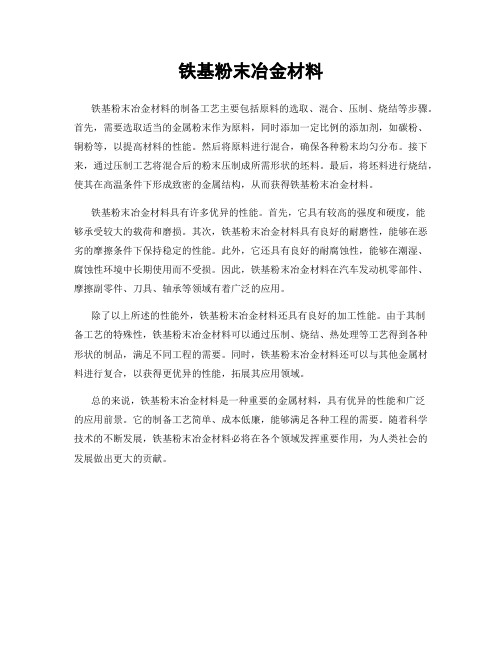
铁基粉末冶金材料
铁基粉末冶金材料的制备工艺主要包括原料的选取、混合、压制、烧结等步骤。
首先,需要选取适当的金属粉末作为原料,同时添加一定比例的添加剂,如碳粉、铜粉等,以提高材料的性能。
然后将原料进行混合,确保各种粉末均匀分布。
接下来,通过压制工艺将混合后的粉末压制成所需形状的坯料。
最后,将坯料进行烧结,使其在高温条件下形成致密的金属结构,从而获得铁基粉末冶金材料。
铁基粉末冶金材料具有许多优异的性能。
首先,它具有较高的强度和硬度,能
够承受较大的载荷和磨损。
其次,铁基粉末冶金材料具有良好的耐磨性,能够在恶劣的摩擦条件下保持稳定的性能。
此外,它还具有良好的耐腐蚀性,能够在潮湿、腐蚀性环境中长期使用而不受损。
因此,铁基粉末冶金材料在汽车发动机零部件、摩擦副零件、刀具、轴承等领域有着广泛的应用。
除了以上所述的性能外,铁基粉末冶金材料还具有良好的加工性能。
由于其制
备工艺的特殊性,铁基粉末冶金材料可以通过压制、烧结、热处理等工艺得到各种形状的制品,满足不同工程的需要。
同时,铁基粉末冶金材料还可以与其他金属材料进行复合,以获得更优异的性能,拓展其应用领域。
总的来说,铁基粉末冶金材料是一种重要的金属材料,具有优异的性能和广泛
的应用前景。
它的制备工艺简单、成本低廉,能够满足各种工程的需要。
随着科学技术的不断发展,铁基粉末冶金材料必将在各个领域发挥重要作用,为人类社会的发展做出更大的贡献。
粉末冶金材料的分类及应用

粉末冶金材料的分类及应用粉末冶金材料的分类及应用粉末冶金材料的分类及应用【摘要】粉末冶金材料有着传统熔铸工艺不能获取的独特化学成分及物理性能,且具有一次成型等特点,因此被广泛应用。
本文主要从粉末冶金材料的主要分类入手,重点对其应用进行了阐述,希望给行业相关人士一定的参考和借鉴。
【关键词】:粉末冶金;材料;分类;应用0.引言所谓的粉末冶金材料指的是用几种金属粉末或者金属与非金属粉末为原料,通过配比、压制成型以及烧结等特殊工艺制成的各类材料的总称,而这种与熔炼和铸造明显不同的工艺也被统称为粉末冶金法。
因其生产流程与陶瓷制品比较类似,所以又被称为金属陶瓷法。
就目前而言,粉末冶金法不单是用来制取某些特殊材料的方法,也是一种优质的少切屑或者无切屑方法,且其具有材料利用率高、生产效率高,节省占地面积及机床等优点。
然而粉末冶金法也并非万能之法,其无论是金属粉末还是模具都有着较高的成本,且制品的形状和大小都受到一定的限制。
1.粉末冶金材料的主要分类1.1传统的粉末冶金材料第一,铁基粉末冶金材料。
作为最传统也是最基本的粉末冶金材料,其在汽车制造行业的应用最为普遍,并随着经济的迅猛发展,汽车工业的不断扩大,铁基粉末冶金材料的应用范围也就变得越来越广阔,因此其需求量也越来越大。
与此同时,铁基粉末冶金材料对其他行业来说也非常重要。
第二,铜基粉末冶金材料。
众所周知,经过烧结铜基制作的零件抗腐蚀性相对来说比较好,且其表面光滑没有磁性干扰。
用来做铜基粉末冶金材料的主要材料有:烧结的青铜材质、黄铜材质以及铜镍合金材料等,此外还有少量的具有弥散性的强化铜等材质。
在现代,铜基粉末冶金材料主要备用到电工器件、机械设备零件等各个制造类领域中,同时也对过滤器、催化剂以及电刷等有一定的作用。
第三,难熔金属材料。
因这类材料的熔点、硬度、强度都比较高,因此其主要成分为难熔性的金属及金属合金复合材料,主要被应用国防、航空航天以及和研究领域等。
第四,硬质合金材料。
铁基粉末冶金材料
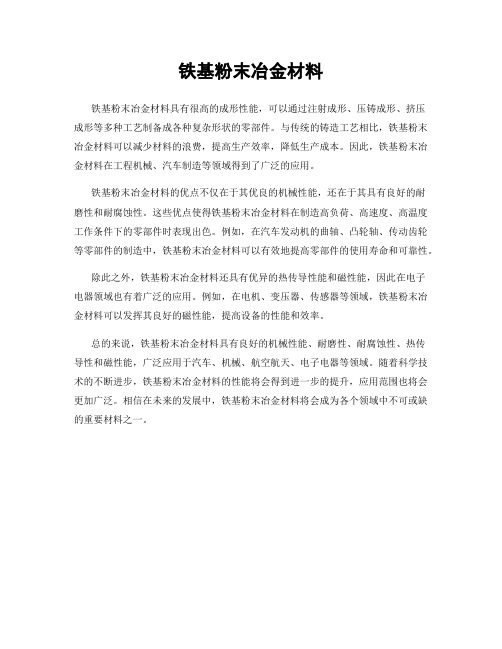
铁基粉末冶金材料
铁基粉末冶金材料具有很高的成形性能,可以通过注射成形、压铸成形、挤压
成形等多种工艺制备成各种复杂形状的零部件。
与传统的铸造工艺相比,铁基粉末冶金材料可以减少材料的浪费,提高生产效率,降低生产成本。
因此,铁基粉末冶金材料在工程机械、汽车制造等领域得到了广泛的应用。
铁基粉末冶金材料的优点不仅在于其优良的机械性能,还在于其具有良好的耐
磨性和耐腐蚀性。
这些优点使得铁基粉末冶金材料在制造高负荷、高速度、高温度工作条件下的零部件时表现出色。
例如,在汽车发动机的曲轴、凸轮轴、传动齿轮等零部件的制造中,铁基粉末冶金材料可以有效地提高零部件的使用寿命和可靠性。
除此之外,铁基粉末冶金材料还具有优异的热传导性能和磁性能,因此在电子
电器领域也有着广泛的应用。
例如,在电机、变压器、传感器等领域,铁基粉末冶金材料可以发挥其良好的磁性能,提高设备的性能和效率。
总的来说,铁基粉末冶金材料具有良好的机械性能、耐磨性、耐腐蚀性、热传
导性和磁性能,广泛应用于汽车、机械、航空航天、电子电器等领域。
随着科学技术的不断进步,铁基粉末冶金材料的性能将会得到进一步的提升,应用范围也将会更加广泛。
相信在未来的发展中,铁基粉末冶金材料将会成为各个领域中不可或缺的重要材料之一。
粉末冶金材料标准表
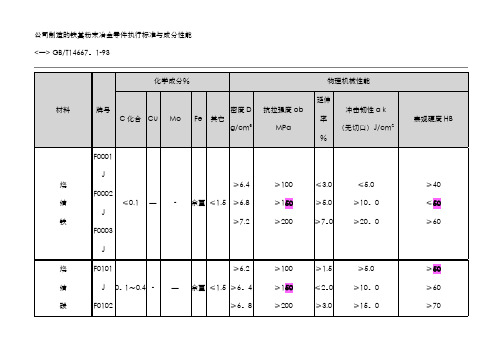
公司制造的铁基粉末冶金零件执行标准与成分性能<一> GB/T14667。
1-93<二〉MPIF-35烧结铁和烧结碳钢的化学成分(%).材料牌号Fe C F—0000 97.7—100 0。
0—0.3 F-0005 97。
4-99.7 0。
3-0。
6 F-0008 97。
1—99。
4 0.6-0.9 注:用差减法求出的其它元素(包括为了特殊目的而添加的其它元素)总量的最大值为2。
0%。
▲烧结铁-铜合金和烧结铜钢的化学成分(%).材料牌号Fe Cu CFC—0200 83.8-98.5 1.5-3。
9 0.0-0。
3FC-0205 93.5—98。
2 1.5—3。
90。
3—0。
6FC-020893。
2-97.9 1.5-3。
9 0.6-0。
9FC-0505 91.4-95。
7 4。
0-6.0 0。
3—0。
烧结铁-镍合金和烧结镍钢的化学成分(%).材料牌号Fe Ni Cu CFN—0200 92.2-99.0 1.0-3。
00。
0-2。
50。
0—0。
3FN-0205 91。
9-98.7 1.0—3。
00。
0—2.50.3-0。
6FN—0208 91.6—98。
4 1。
0-3.0 0.0-2.50。
6-0。
9注:用差减法求出的其它元素(包括为了特殊目的而添加的其它元素)总量的最大值为2。
0%。
6FC-0508 91.1—95。
4 4.0—6。
0 0。
6-0.9FC—0808 88.1-92.4 7.0-9.0 0.6-0.9FC-1000 87.2-90。
59。
5—10。
50.0-0。
3FN-0405 89。
9—96.7 3.0-5。
50。
2—2.00.3—0.6FN—040889。
6—96。
43.0—5.50。
0-2。
0。
6—0。
9注:用差减法求出的其它元素(包括为了特殊目的而添加的其它元素)总量的最大值为2.0%⊙ 铁—铜合金和铜钢粉末冶金材料性能(MPIF—35)铁—镍合金和镍钢粉末冶金材料性能(MPIF-35)↑上一页⊙不锈钢系列粉末冶金制品执行标准与典型牌号的成分和性能-不锈钢(MPIF-35)⊙ 铜基系列粉末冶金制品 执行标准成分与性能-铜基(GB2688-81)⊙ <三> ”DIN V 30 910” 及 "ISO5755” (成分与性能略) ⊙ 烧结铝镍钴永磁合金的磁特性及其它物理特性< 規 格 二 — 不銹鋼 〉TypeChemical Composition (%)Physical Mechanical PropertiesFe Cr Ni Cu Tin Si Mn Mo C S Other Density(g/cm 3) Ultimate Tensile Strength (kg/mm 2)Elong-ation(%) Hard-nessSUS303LSCba l 18。
粉末冶金铁基结构材料力学性能

烧结状态 体
热处理状态
类
牌号
积抗伸
表处
表
别
质拉
弹性模 现 理 抗拉强 现
长
量强
量 硬方 度 硬
率
度
度法
度
应用
烧
塑性、韧性、焊接性与导磁性较好,适用于
结 FTG10-10 6.3 100 3.0 78400 40 -
-
- 受力极小,要求翻铆或焊接及要求导磁的零
铁
件,如垫片、磁筒、极靴等
2.提高材料性能。用特殊方法制取的细小金属或合金粉末,凝固速度极快、晶粒细小均匀,保证了材料的组织均匀,性能稳定, 以及良好的冷、热加工性能,且粉末颗粒不受合金元素和含量的限制,可提高强化相含量,从而发展新的材料体系。
3.利用各种成形工艺,可以将粉末原料直接成形为少余量、无余量的毛坯或净形零件,大量减少机加工量。提高材料利用率, 降低成本。
烧
塑性、韧性、焊接性与导磁性较好,适用于
结 FTG10-15 6.8 150 5.0 88200 50 -
-
- 受力极小,要求翻铆或焊接及要求导磁的零
铁
件,如垫片、磁筒、极靴等
烧
塑性、韧性、焊接性与导磁性较好,适用于
结 FTG10-20 7.0 200 7.0 98000 60 -
-
- 受力极小,要求翻铆或焊接及要求导磁的零
-
碳
钢
强度较高,适用于轻载结构件,如隔套、接
-
头、调节螺母、传动小齿轮等
烧
结
淬
强度较高,适用于轻载结构件,如隔套、接
中 FTG60-20 6.5 200 1.5 88200 70
450 45
铁基粉末冶金材料

铁基粉末冶金材料铁基粉末冶金材料是一种重要的金属材料,它以铁粉为主要原料,经过混合、压制、烧结等工艺制成的一种新型金属材料。
铁基粉末冶金材料具有优异的性能和广泛的应用领域,被广泛应用于汽车、机械、电子、航空航天等领域。
本文将从铁基粉末冶金材料的制备工艺、性能特点及应用领域等方面进行介绍。
一、铁基粉末冶金材料的制备工艺。
铁基粉末冶金材料的制备工艺包括原料准备、混合、压制、烧结等多个步骤。
首先,选择适当的铁粉和合金粉作为原料,然后进行粉末的干法或湿法混合,以确保各种元素均匀分布。
接下来,将混合后的粉末通过压制工艺成型,通常采用冷压或热压的方式。
最后,通过烧结工艺将粉末冶金材料加热至一定温度,使其颗粒间发生扩散和结合,形成致密的金属材料。
二、铁基粉末冶金材料的性能特点。
铁基粉末冶金材料具有许多优异的性能特点,主要包括高强度、高硬度、耐磨损、耐腐蚀等。
首先,由于其微观组织致密,具有较高的强度和硬度,能够满足各种复杂工况下的使用要求。
其次,铁基粉末冶金材料具有良好的耐磨损性能,适用于各种高磨损场合的零部件制造。
此外,铁基粉末冶金材料还具有良好的耐腐蚀性能,可用于制造耐腐蚀零部件。
三、铁基粉末冶金材料的应用领域。
铁基粉末冶金材料具有广泛的应用领域,主要应用于汽车、机械、电子、航空航天等领域。
在汽车领域,铁基粉末冶金材料常用于发动机、变速箱、转向系统等零部件的制造,以提高汽车的性能和可靠性。
在机械领域,铁基粉末冶金材料常用于制造各种高强度、耐磨损的零部件,如齿轮、轴承等。
在电子领域,铁基粉末冶金材料常用于制造电磁元件、传感器等零部件。
在航空航天领域,铁基粉末冶金材料常用于制造各种高强度、耐高温、耐腐蚀的零部件,如发动机叶片、涡轮盘等。
综上所述,铁基粉末冶金材料是一种重要的金属材料,具有优异的性能和广泛的应用领域。
随着科学技术的不断发展,铁基粉末冶金材料将在更多领域发挥其重要作用,为人类社会的发展做出更大的贡献。
铁基粉末冶金材料
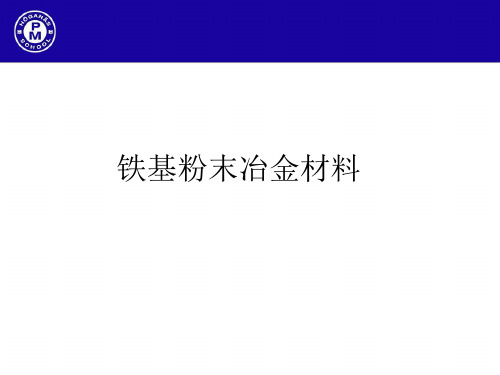
• Excessive die wall wear or insufficient lubrication may result in cold welding of the compact to the die wall.
• Results in increased ejection force and stick-slip behaviour (squeaky noise)
影响尺寸变化的因素
• Particle size • Alloying element • Uneven filling and compaction • Uneven distribution of alloying elements in the
component • Liquid phase formation • Sintering temperature and time • Uneven temperature distribution of the sintering
后续处理
Treatment
Definition
Examples
Thermal treatments
Change in microstructure of the surface layers of the original substrate by thermally cycling through a phase transformation
由于精确的成型技术,粉末冶金产品具有以下特点: 近净成型 形状复杂 优良的尺寸精度.
粉末冶金简介
粉末冶金技术发展迅速: 其原料涵盖了近乎所有技术元素 产品形状复杂程度日益提高
粉末冶金产业主要分为两个领域: 铁基粉末冶金润滑制品 • 结构件 • 软磁材料
金属粉末冶金材料标准表

材料牌号
最小强度 (A)(E)
屈服 极限
FN-0200-15 -20 -25
FN-0205-20 -25 -30 -35
FN-0205-80HT -105HT -130HT -155HT -180HT
FN-0208-30 -35 -40 -45 -50
FN-0208-80HT -105HT -130HT -155HT -180HT
屈服强 度
(0.2%) MPa 120 170 210 170 210 240 280
(D)
240 280 310 340 380
(D)
210 280 340
(D)
280 340 410
伸长率 (25.4mm)
3.0 5.0 10.0 1.5 2.5 4.0 5.5 < 0.5 < 0.5 < 0.5 < 0.5 < 0.5 1.5 1.5 2.0 2.5 3.0 < 0.5 < 0.5 < 0.5 < 0.5 < 0.5 < 1.0 3.0 4.5 < 0.5 < 0.5 < 0.5 < 0.5 < 0.5 1.0 1.0 1.0
FC-0205 93.5-98.2 1.5-3.9 0.3-0.6
FC-0208 93.2-97.9 1.5-3.9 0.6-0.9
FC-0505 91.4-95.7 4.0-6.0 0.3-0.6
FC-0508 91.1-95.4 4.0-6.0 0.6-0.9
FC-0808 88.1-92.4 7.0-9.0 0.6-0.9
硬度
宏观 (表现)
微观 (换算的)
密度
络氏
铁基粉末冶金材料的制备及性能研究

铁基粉末冶金材料的制备及性能研究一、引言粉末冶金是一种高效、环保的先进制造技术。
铁基粉末冶金材料是目前粉末冶金领域中使用最为广泛的一种材料,在机械、汽车、电子、航空、航天等领域得到了广泛的应用。
如何制备高品质的铁基粉末冶金材料,提高其性能,是当前研究的热点和难点之一。
二、铁基粉末冶金材料的制备方法目前,铁基粉末冶金材料的制备方法主要分为干法和湿法两种。
1. 干法干法制备铁基粉末冶金材料的主要原理是将金属粉末通过机械合金化或电解粉末制备得到所需的铁基合金粉末。
干法制备铁基粉末冶金材料的优点是工艺简单,易于控制,且不需要添加外来成分,从而提高了制备的纯度。
2. 湿法湿法制备铁基粉末冶金材料的主要原理是先制备出高纯度的沉淀物,然后再通过还原、热处理等方法制备所需的粉末冶金材料。
湿法制备铁基粉末冶金材料的优点是可以获得更高的成分均匀度和纯度,且可以控制尺寸和形状,但缺点是制备工艺比较繁琐,成本较高。
三、铁基粉末冶金材料的性能研究铁基粉末冶金材料的性能研究主要包括以下几个方面:1. 硬度和耐磨性铁基粉末冶金材料的硬度和耐磨性是其最重要的性能之一。
硬度和耐磨性一般受到材料的成分、制备和加工过程的影响。
研究表明,适当的碳含量和孔隙率可以提高材料的硬度和耐磨性。
2. 抗拉强度和塑性铁基粉末冶金材料的抗拉强度和塑性是其在机械、汽车等领域应用的重要指标。
一般来说,选择合适的铁基合金、控制铁基合金的粘结相以及调整材料的含碳量,可以提高材料的抗拉强度和塑性。
3. 磁性铁基粉末冶金材料的磁性是其在电子、磁性材料等领域应用的重要指标。
研究发现,采用适当的热处理等方法可以调控铁基粉末冶金材料的磁性。
4. 抗腐蚀性铁基粉末冶金材料的抗腐蚀性是其在冶金、化学等领域应用的重要指标。
一般来说,选择合适的铁基合金、降低材料的孔隙率以及控制材料的表面质量,可以提高材料的抗腐蚀性。
四、铁基粉末冶金材料的应用铁基粉末冶金材料可以广泛应用于机械、汽车、电子、航空、航天等领域。
铁基粉末冶金材料成分

铁基粉末冶金材料成分铁基粉末冶金材料,这个名字听起来是不是有点高大上?其实吧,铁基粉末冶金材料就像是一块块小拼图,经过巧妙的组合,最后拼出了一幅大画面,特别有意思。
而且在我们的生活中,它的身影可不少哦,就像那不知疲倦的小蜜蜂,忙碌地在各个领域飞来飞去。
想想看,汽车、机械、工具,还有好多工业产品,背后都离不开这些铁基材料的支持,真是“功臣”啊。
说到铁基粉末冶金材料,得先聊聊它的成分。
嘿,听着就有点专业,但其实没那么复杂。
铁,作为主要成分,简直就是个“主力军”,没有它,整个阵营就不行了。
而且铁的价格也亲民,让很多企业可以放心使用。
然后再加上一些其他元素,比如碳、镍、铬、钼什么的,这些元素就像调味料,把铁基材料的性能提升得更上一层楼。
有了这些配方,材料的强度、韧性、耐磨性,都能大大增强,感觉就像给材料穿上了“防弹衣”。
粉末冶金的魅力不仅在于它的成分,还在于它的制造过程。
你知道吗,粉末冶金的过程就像是在做一顿大餐。
要把金属原料弄成粉末,听起来简单,实际操作起来可是有点讲究哦。
得控制好粉末的颗粒度,太大了不好,太小了也不行,得刚刚好,才有那个“滋味”。
把粉末按一定的比例混合,像调色一样,调出最佳的“配方”。
然后压制成型,就像捏泥巴,形状随心所欲,最后烧结,把这些小粉末通过高温让它们紧密结合在一起,哇,这个过程就像是把小零件变成了大宝贝,十分神奇。
粉末冶金材料的优点还真不少。
比如,使用材料的利用率高,几乎没有浪费,简直就是环保小卫士。
而且生产的产品可以达到很高的精度,像打磨过一样,真是让人惊叹。
此外,经过适当处理,这些材料的性能可是不容小觑,耐腐蚀、耐高温、耐磨损,仿佛有了超能力,能在恶劣的环境中也能安然无恙。
听着是不是很酷?说到应用,那就更广泛了。
汽车工业中,铁基粉末冶金材料是不可或缺的,比如齿轮、轴承,这些小配件可是维持整个汽车运行的关键哦。
航空航天领域也需要它们,想想那些飞翔在天上的飞机,背后有多少技术支持,铁基材料可真是默默无闻的“英雄”。
铁基粉末冶金的一些知识点

铁基粉末冶金的一些知识点概述铁基粉末冶金是一种先进的冶金加工技术,它是通过制备高纯度、均匀性良好的铁基粉末,并在高温下烧结而制成的一类高强度、耐磨性和抗疲劳性强的粉末冶金材料。
铁基粉末冶金是一种无冶炼方法,因此能够大幅度降低生产成本。
同时,由于铁基粉末冶金所制备的材料具有优异的物理和化学性能,因此在航空、汽车、船舶等领域得到广泛应用。
制备工艺铁基粉末冶金有两个重要的制备工艺:粉末冶金和热等静压。
其制备工艺大致如下:粉末冶金1.制备金属纤维素泡沫;2.将金属纤维素泡沫和其它金属材料分离并粉碎;3.将粉碎后的材料放入一定比例的氯化铁中,反应生成相应的金属氧化物和氯化氢;4.再用高温煅烧和化学气相沉积的方法制备出铁基粉末。
热等静压1.将制备好的铁基粉末放入模具中;2.在高温下施加静压,使得粉末颗粒间形成高度强化相互作用;3.再进行热处理,以消除内部应力和缺陷,从而得到一种具有高密度、高强度和高韧性的金属材料。
材料性能铁基粉末冶金材料具有以下优越性能:1.高强度:经过热等静压工艺处理后,材料的接口黏着力更好,因此具有更高的强度和更好的耐磨性;2.抗疲劳性:铁基粉末冶金材料经过热等静压处理后,其在高温下的表现非常优秀,能够抵抗高强度、多变形式等多种极端状况,并具有较长的使用寿命;3.高温性能良好:经过高温烧结的铁基粉末冶金材料具有良好的高温耐受能力,能够在高温环境下使用。
应用领域铁基粉末冶金在许多领域都有广泛的应用:1.航空领域:铁基粉末冶金材料具有高刚性、高耐磨性和高强度等优点,因此在航空制造中得到广泛应用,如飞机发动机、变速器、航空部件等;2.汽车领域:铁基粉末冶金材料能够大幅度降低汽车重量,提高汽车的燃油效率和动力性能;3.船舶领域:铁基粉末冶金材料具有良好的耐磨性和抗腐蚀性能,在船舶建造等领域得到广泛应用。
结论铁基粉末冶金技术是一种先进的金属材料加工技术,具有高强度、高韧性、耐高温、抗疲劳等优秀性能,其所制备的材料在航空、汽车、船舶等领域有着广泛的应用前景。
din 16196标准
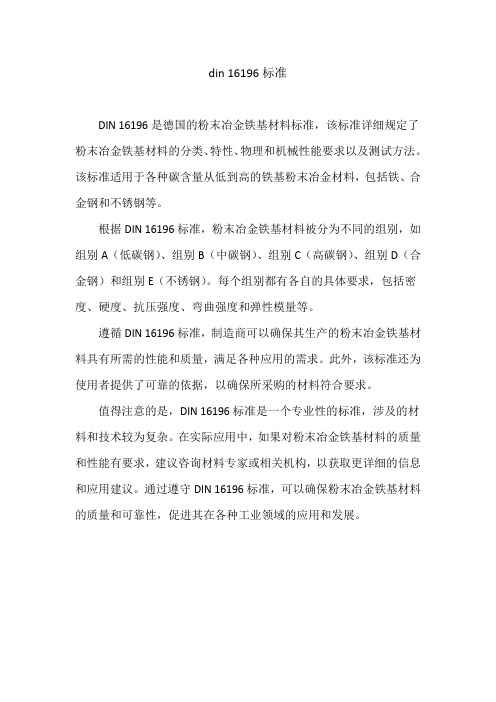
din 16196标准
DIN 16196是德国的粉末冶金铁基材料标准,该标准详细规定了粉末冶金铁基材料的分类、特性、物理和机械性能要求以及测试方法。
该标准适用于各种碳含量从低到高的铁基粉末冶金材料,包括铁、合金钢和不锈钢等。
根据DIN 16196标准,粉末冶金铁基材料被分为不同的组别,如组别A(低碳钢)、组别B(中碳钢)、组别C(高碳钢)、组别D(合金钢)和组别E(不锈钢)。
每个组别都有各自的具体要求,包括密度、硬度、抗压强度、弯曲强度和弹性模量等。
遵循DIN 16196标准,制造商可以确保其生产的粉末冶金铁基材料具有所需的性能和质量,满足各种应用的需求。
此外,该标准还为使用者提供了可靠的依据,以确保所采购的材料符合要求。
值得注意的是,DIN 16196标准是一个专业性的标准,涉及的材料和技术较为复杂。
在实际应用中,如果对粉末冶金铁基材料的质量和性能有要求,建议咨询材料专家或相关机构,以获取更详细的信息和应用建议。
通过遵守DIN 16196标准,可以确保粉末冶金铁基材料的质量和可靠性,促进其在各种工业领域的应用和发展。
粉末冶金材料标准表

公司制造的铁基粉末冶金零件执行标准与成分性能<一> GB/<二> MPIF-35F-0008-50HT-65HT-75HT-85HT 380450< S 48022HRC60HRC 450520< 5502860 520590< 6203260 590660< 6903560烧结铁和烧结碳钢的化学成分(%).材料牌号Fe CF-0000注: 用差减法求出的其它元素(包括为了特殊目的而添加的其它元素)总量的最大值为%。
▲注: 用差减法求出的其它元素(包括为了特殊目的而添加的其它元素)总量的最大值为%。
烧结铁-铜合金和烧结铜钢的化学成分(%).材料牌号Fe Cu CFC-0200烧结铁-镍合金和烧结镍钢的化学成分(%).材料牌号Fe Ni Cu CFN-0200注: 用差减法求出的其它元素(包括为了特殊目的而添加的其它元素)总量的最大值为%⊙铁-铜合金和铜钢粉末冶金材料性能(MPIF-35)材料编号最小强度(A)(E)拉伸性能横向断裂压缩屈服硬度密度屈服极限极限强度屈服强度伸长率宏观微观铁-镍合金和镍钢粉末冶金材料性能(MPIF-35)↑上一页⊙不锈钢系列粉末冶金制品执行标准与典型牌号的成分和性能-不锈钢(MPIF-35)⊙铜基系列粉末冶金制品执行标准成分与性能-铜基(GB2688-81)<三>"DIN V 30 910" 及"ISO5755" (成分与性能略)⊙烧结铝镍钴永磁合金的磁特性及其它物理特性< 規格二- 不銹鋼>FTG60-25(50R) 材料的力学性能。
铁基粉末冶金烧结材料的选择标准

页码,1/2
初次访问操作流程:会员注册 进入商务室
当前位置:首页->行业资讯
行业动态 |
铁基粉末冶金烧结材料的选择准则 2006-3-20 浏览选项: 字体大小
颜色
铁基烧结材料的选择准则如下: 1.烧结碳钢和烧结铜钢 1)相对密度为74.3%-84.5%的烧结碳钢和烧结铜钢。它们适用于对韧度无特殊要求,承受低或中等应力、需要具有自
服务热线:0571-85132819 85235193 传真:0571-85235193
客户服务:fw@ 广告联系:adv@
客服QQ:496617775
客服MSN: pmbiz1@
3721 网络实名:粉末冶金商务、粉末冶金商务网、中国粉末冶金商务网 联盟网站:中国硬质合金商务
级。 当以高压缩性水雾化铁粉与磷铁粉的混合粉作为原料粉时,可以制造形状复杂的,相对密度为90.2%一95.3%的烧结 3.烧结镍钢 在既需要强度(它是碳与镍含量的函数)又需要高韧度的条件下,可采用烧结镍钢,其在疲劳与冲击动态应力作用下性 烧结镍钢不宜进行水蒸气处理,因为这会减低其韧度。其他后续处理和烧结铜钢相同。4.烧结铜镍钢 同时用铜与镍进行合金化,是为了稳定烧结零件的尺寸。和上面列举的各种烧结钢相比,截面的淬透性较大。韧度比
本网站由中国机械工程学会粉末冶金分会、华东五省一市粉末冶金学会及杭州极点科技有限公司共同建
ICP证:浙B2-20050270
/news/info.asp?id=1915 PDF created with pdfFactory Pro trial version
力学性能好。这种烧结钢适于制造承受高应力的零件。 需要进一步提高强度时,可进行热处理(渗碳一淬火或淬火)。这种烧结钢不宜进行水蒸气处理,但若密度高时,可进行表面
铁基粉末冶金硬度
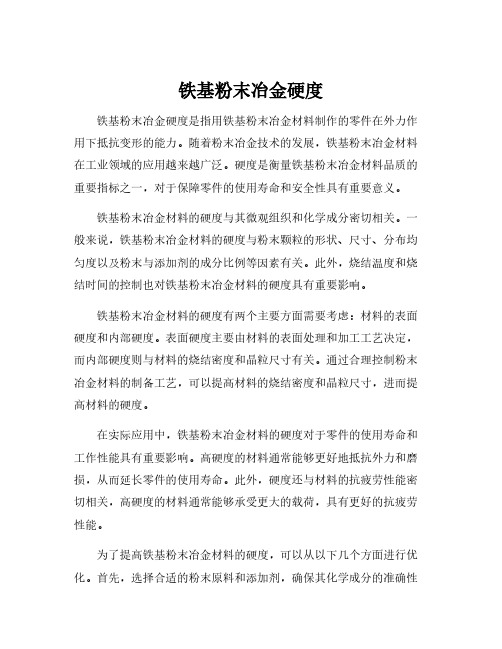
铁基粉末冶金硬度铁基粉末冶金硬度是指用铁基粉末冶金材料制作的零件在外力作用下抵抗变形的能力。
随着粉末冶金技术的发展,铁基粉末冶金材料在工业领域的应用越来越广泛。
硬度是衡量铁基粉末冶金材料品质的重要指标之一,对于保障零件的使用寿命和安全性具有重要意义。
铁基粉末冶金材料的硬度与其微观组织和化学成分密切相关。
一般来说,铁基粉末冶金材料的硬度与粉末颗粒的形状、尺寸、分布均匀度以及粉末与添加剂的成分比例等因素有关。
此外,烧结温度和烧结时间的控制也对铁基粉末冶金材料的硬度具有重要影响。
铁基粉末冶金材料的硬度有两个主要方面需要考虑:材料的表面硬度和内部硬度。
表面硬度主要由材料的表面处理和加工工艺决定,而内部硬度则与材料的烧结密度和晶粒尺寸有关。
通过合理控制粉末冶金材料的制备工艺,可以提高材料的烧结密度和晶粒尺寸,进而提高材料的硬度。
在实际应用中,铁基粉末冶金材料的硬度对于零件的使用寿命和工作性能具有重要影响。
高硬度的材料通常能够更好地抵抗外力和磨损,从而延长零件的使用寿命。
此外,硬度还与材料的抗疲劳性能密切相关,高硬度的材料通常能够承受更大的载荷,具有更好的抗疲劳性能。
为了提高铁基粉末冶金材料的硬度,可以从以下几个方面进行优化。
首先,选择合适的粉末原料和添加剂,确保其化学成分的准确性和均匀性。
其次,在制备过程中控制烧结温度和时间,以保证材料的烧结密度和晶粒尺寸。
最后,采用合适的表面处理和加工工艺,提高材料的表面硬度。
总之,铁基粉末冶金材料的硬度是影响其品质和使用寿命的重要指标。
通过加强对材料制备过程的控制和优化,可以提高铁基粉末冶金材料的硬度,进而提高零件的使用寿命和工作性能。
对于从事粉末冶金领域的研究者和工程师来说,了解和掌握铁基粉末冶金材料硬度的影响因素和提高方法,对于提升产品质量和技术水平具有重要的指导意义。
铁基粉末冶金材料牌号
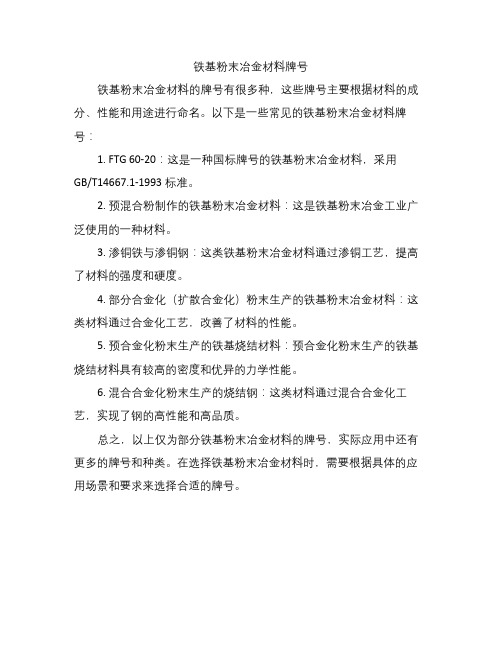
铁基粉末冶金材料牌号
铁基粉末冶金材料的牌号有很多种,这些牌号主要根据材料的成分、性能和用途进行命名。
以下是一些常见的铁基粉末冶金材料牌号:
1. FTG 60-20:这是一种国标牌号的铁基粉末冶金材料,采用
GB/T14667.1-1993标准。
2. 预混合粉制作的铁基粉末冶金材料:这是铁基粉末冶金工业广泛使用的一种材料。
3. 渗铜铁与渗铜钢:这类铁基粉末冶金材料通过渗铜工艺,提高了材料的强度和硬度。
4. 部分合金化(扩散合金化)粉末生产的铁基粉末冶金材料:这类材料通过合金化工艺,改善了材料的性能。
5. 预合金化粉末生产的铁基烧结材料:预合金化粉末生产的铁基烧结材料具有较高的密度和优异的力学性能。
6. 混合合金化粉末生产的烧结钢:这类材料通过混合合金化工艺,实现了钢的高性能和高品质。
总之,以上仅为部分铁基粉末冶金材料的牌号,实际应用中还有更多的牌号和种类。
在选择铁基粉末冶金材料时,需要根据具体的应用场景和要求来选择合适的牌号。
粉末冶金材料标准表

(公司制造的铁基粉末冶金零件执行标准与成分性能<一> GB/<二> MPIF-35烧结铁和烧结碳钢的化学成分(%).;材料牌号Fe CF-0000-注: 用差减法求出的其它元素(包括为了特殊目的而添加的其它元素)总量的最大值为%。
▲注: 用差减法求出的其它元素(包括为了特烧结铁-铜合金和烧结铜钢的化学成分(%).材料牌号Fe Cu C~FC-0200(;,烧结铁-镍合金和烧结镍钢的化学成分(%).#材料牌号Fe Ni Cu CFN-0200`#、注: 用差减法求出的其它元素(包括为了特殊殊目的而添加的其它元素)总量的最大值为%。
\&目的而添加的其它元素)总量的最大值为%⊙ 铁-铜合金和铜钢粉末冶金材料性能(MPIF-35)材料编号最小强度(A)(E){拉伸性能横向断裂压缩屈服强度%)硬度密度屈服极限'极限强度屈服强度%)伸长率宏观(表现)微观(换算的)MPa MPa MPa%MPa MPa络氏…g/cm3FC-0200-15-18-21-24 100170140310&12011HRBN/A 120190~16035014018|14021018039016026170230200/43018036FC-0205-30-35-40-45 210<240240< 41034037HRBN/A 240280280< 520370|48280340310…<66039060310410340< 79041072.FC-0205-60HT 410480< 660《19HRC58HRC—铁-镍合金和镍钢粉末冶金材料性能(MPIF-35)↑上一页⊙不锈钢系列粉末冶金制品执行标准与典型牌号的成分和性能-不锈钢(MPIF-35)⊙铜基系列粉末冶金制品执行标准成分与性能-铜基 (GB2688-81)<三> "DIN V 30 910" 及 "ISO5755" (成分与性能略)⊙烧结铝镍钴永磁合金的磁特性及其它物理特性< 規格二 - 不銹鋼 >TypeChemical Composition (%) Physical Mechanical PropertiesFe《Cr Ni Cu Tin Si Mn Mo C&SOther Density(g/cm3)UltimateTensileStrength(kg/mm2)Elong-ation(%)Hard-nessSUS303LSC bal 《–<】< > 20 Min.FTG60-25(50R) 材料的力学性能。
表面强化铁基粉末冶金材料的表面处理工艺探究
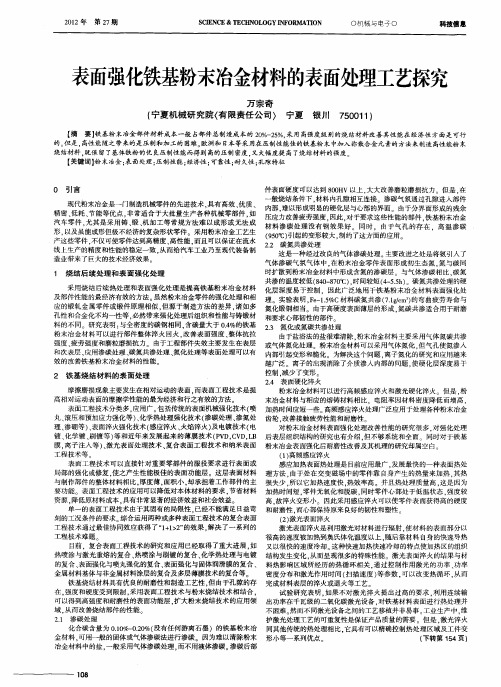
【 关键词】 粉末冶金 ; 表面处理; 压制性能; 经济性; 可靠性; 耐久性; 孔隙特征
0 引言
现代粉末冶金是一门制造机 械零件 的先进技术 具有 高效 、 优质 、 精密、 低耗 、 节能等优点 . 非常适合于大批量生 产各 种机械零部件 . 如 汽车零件 , 尤其是采 用铸 、 、 锻 机加工等 常规方法难 以成形 或无法 成 形, 以及虽 能成形但极不经济的复杂形状零 件。采用粉末 冶金 工艺生 产这些零件 , 不仅可使零件达到高精度 、 高性 能。 而且 可以保证 在流水 22 碳 氮共 渗 处 理 . 线 上生产 的精度和性能的稳定一 致 . 给汽 车工业乃至现代 装备制 从而 这是一种经过改 良的气体渗碳处理 。 主要改进之处是将氨引入了 造业带来 了巨大 的技术经济效果 气体渗碳气氛气体 中 . 粉末冶金零件表 面形成 初生态氮 . 在 氮与碳 同 时扩散到粉末冶金材料 中形成含 氮的渗碳层 。与气体渗碳相 比. 碳氮 1 烧 结 后 续 处 理 和 表 面 强化 处 理 共渗的温度较低 (4 — 7 T )时间较短( — . ) 8 0 80  ̄ . 4 5 h 碳氮共渗处理的硬 5 采 用烧结后续热处理 和表面强化处理是提 高铁基粉末冶金材料 化层深度 易于控制 .因此广泛地用 于铁基 粉末冶金材料表面强 化处 及部件性 能的最经济有效的方法。 虽然粉末冶金零件 的强化处理和相 理 。实验表明 ,e 1 %C材料碳 氮共 渗( . / 的弯 曲疲劳 寿命 与 F一. 5 71 e ) gm 应的锻轧金属零件或 锻件原理相似 . 源于制造方法 的差异 . 但 诸如多 氮化锻钢相当。由于高硬度表面薄层 的形成 , 共渗适合用于耐磨 氮碳 L 和合金化不均一性等 . 性 必然带来强化 处理后组织和性能与铸锻材 和要求心部韧性 的部件 料 的不 同。研究表明 : 与全密度 的碳钢相 同, 含碳量大于 O %的铁基 2 氮化或氮碳共渗处理 . 4 - 3 粉末冶金材料可 以进行 部件整体淬火 回火 . 改善表面强度 、 体抗拉 整 由于盐浴法的盐很难清除 . 粉末冶金材料主要采用气体氮碳共渗 强度 、 疲劳 强度和磨粒磨损抗力 由于工程部件失效主要发生在表层 或气体氮化处理 。粉末冶金材料可以采用气体 氮化 , 气孔使 氮渗入 但 和次表层 , 应用渗碳处理 、 碳氮共渗处理 、 氮化处理等表面处理 可以有 内部引起变形 和脆化 为解决这个问题 . 子氮 化的研 究和应用越来 离 效的改善铁基粉末冶金材料的性能 越广泛 离子的出现消除 了介质渗入 内部的问题 , 使硬化层深度易于 控制 . 减少了变形 2 铁基 烧 结材 料 的表 面 处 理 24 表面硬化淬火 . 摩擦磨损现象主要发生在相对运动的表面 . 而表面工程技术是提 粉末冶金材料可以进行高频感应淬火和激光硬化淬火 但是 . 粉 高相对运动表面的摩擦学性能 的最为经济和行 之有效 的方法 。 末冶金材料与相应的熔铸材料相 比.电阻率因材料密度降低而增高 . 表面工程 技术分类 多, 应用广 。 包括传统的表面机械强化技术 ( 喷 加热时 间应短一些 高频感应淬火处理广泛应用于处理各种粉末冶金 丸、 滚压和预加应 力强化等 )化学热处理强化技术( 、 渗碳处理 、 渗氮处 齿轮 . 改善接触疲劳性 能和耐磨性 理、 渗硼等) 表面淬火强化技术 ( 、 感应淬火 、 火焰淬火 ) 及电镀技术 ( 电 对粉末冶金材料表 面强化处理改善性能的研究很多 . 对强化处理 镀 、 学镀 、 化 刷镀等 ) 和近年来发展起 来的薄膜 技术 (V C D L 后表层组织结构的研究 也有介绍 . 等 P D, V ,B 但不够系统和全面 同时对于铁基 膜, 离子注入 等) 激光表面处理技术 、 、 复合表面工程技术 和纳米表面 粉末冶金表面强化后耐磨性改善及其机理的研究却属空 白 工程技术等。 ( 频 感 应淬 火 1高 表 面工程技术可 以直接针对 重要零部件 的服役要求 进行表面或 感应加热表面热处理是 目 前应用最广 . 发展最快 的一种表 面热处 局部的强化或修复 . 使之产 生性能极佳 的表面功能层 。这层表 面材料 理方法 . 由于处在交变磁场 中的零件靠 自身产生 的热 量来加热 . 其热 与制作部件的整体材料相 比, 厚度薄 , 面积小 , 却承担着工作部件 的主 损 失少 , 以它加热速度快 , 所 热效率高 。并且热处理质量高 , 因为 这是 要功能 表面工程技术的应用 可以降低对本体材料 的要求 . 节省材料 加热时间短 . 零件无氧化和脱 碳. 同时零件心部处于低温状态 , 强度较 资源 , 降低原材料成本 . 具有非 常显著 的经济效益和社会效益 。 高. 故淬火变形小 因此采用 感应淬火可 以使零件表面获得高 的硬度 单一的表面工程技术由于其 固有 的局限性 . 已经不能满足 日益苛 和耐磨性 . 而心部保持原来 良好的韧性和塑性 刻 的工况条件的要求 综合运用两种或多种表面工程技术的复合表 面 ( ) 光 表 面 淬 火 2激 工程技术通过最佳协 同效应 获得 了“+ > ” 1 1 2 的效果 . 决了一系列 的 解 激光表面淬火是利用激光对材料进行辐射 . 使材料 的表面部分 以 工程技术难题 很 高的速度被加热到奥 氏体化温度以上 . 随后靠材 料 自身的快速导热 目 .复合表面工程技术 的研究 和应用 已经取得 了重 大进 展 , 前 如 又 以 快的速度冷却 很 这种快速加热快速冷却 的特点使加热 区的组织 热 喷涂 与激光重熔的复合 、 热喷涂与刷镀 的复合、 化学热处理 与电镀 结构发生变化 , 从而呈现很多的特殊性能。激光表面淬火的结果与材 的复合 、 表面强化与喷丸强化的复合、 表面强 化与固体润 滑膜的复合 、 料热影响 区域所 经历 的热循环相关 . 过控制作用激光 的功率 、 通 功率 金属材料基体与非金属材料涂层的复合及多层薄膜技术的复合等 密度分布和激光作用 时间( 扫描速度 ) 等参 数 , 可以改变热循 环 . 从而 铁基烧结材料具有优 良的耐磨性 和制造工艺性 。 由于孔 隙的存 完成材料表层 的淬火或退火等工艺 但 在. 强度和硬度受到 限制 . 采用表面工程技术 与粉末 烧结技 术相结合 . 试验研究表 明 . 如果不对激光淬火 提出过高的要求 . 利用 连续输 可以得 到高强度和耐磨性的表面功 能层 . 扩大粉末烧结 技术 的应用 领 出功率在千瓦级 的二氧化碳激光设备 . 铁基材料表面进行热处理并 对 域. 从而改善烧结部件的性能 不困难 。 然而不同激光设备之 间的工艺移植并非易事。 工业生产中 , 维 21 渗 碳 处 理 . 护激光处理工艺的可重复性是保证产品质量 的需要 。但是 . 激光淬火 化合碳含量 为 01%一 .0 没有任何游离石墨 )的铁基粉末冶 同其他传统的热处理相 比. .0 02 %( 它具有可以精确控制热处理 区域及工件变 金材料 , 可用一般 的固体或气体渗碳法进行 渗碳 因为难以清除粉末 形小等一系列优点。 ( 下转第 1 4页 ) 5 冶金材料 中的盐 , 一般采用气体渗碳处理 . 而不用液体渗碳 。 渗碳后部
铁基粉末冶金材料感应烧结过程研究

2 0 1 3年 8月
粉末 冶金 技术
Po wd er Me t a l l ur g y Te c hno l o gy
Vo 1 . 31. No . 4 Au g . 2 01 3
铁 基 粉 末 冶金 材 料 感 应 烧 结 过 程 研究
程 敏 李 明威 申小 平
Re s e a r c h o n i n du c t i o n s i n t e r i n g o f i r o n- b a s e d P/ M ma t e r i a l
Che ng Mi n, Li Mi ng we i ,She n Xi a op i ng
Ab s t r a c t :Th e i nf lu e nc e o f pa r t i c l e s i z e, c o mpa c t d e ns i t y a nd s i n t e r i n g c u r r e n t o n i nd u c t i o n s i n t e r i n g p r o c e s s a n d pe fo r r ma n c e o f i r o n— b a s e d p o wd e r me t a l l u r g y ma t e r i a l we r e s t ud i e d b y c o a r s e i r o n po wd e r a s t h e ma i n r a w ma t e r i a 1 . The r e s u l t s s ho w t ha t d e c r e a s e o f p a r t i c l e s s i z e a n d i n c r e a s e o f de n s i t y a nd c u r r e n t c a n p r o d uc e mo r e qu a n t i t y o f h e a t a nd pr o mo t e t h e s i n t e r i ng p r o c e s s .Wh e n s i n t e r i n g b e g i n s,t h e h a r d ne s s o f p o wde r pa r t i c l e s de c r e a s e s a nd t h e wo r k h ar de n i n g p he n o me no n e l i mi n a t e s, S O t h e ha r d n e s s o f ma t e r i a l r ed u c e s a t f i r s t ,a n d t h e n t e n ds t o be s t a b l e a n d s l i g ht l y i nc r e a s e s i n t h e e nd . The c o ro s i o n r e s i s t a nc e o f ma t e r i a l i n c r e a s e s wi t h s i n t e r i n g t i me . Ke y wo r ds:i r o n— b as e d P/M ma t e r i a l ;i n d uc t i o n s i n t e r i n g;h a r d ne s s;c o r r o s i o n r e s i s t a nc e
- 1、下载文档前请自行甄别文档内容的完整性,平台不提供额外的编辑、内容补充、找答案等附加服务。
- 2、"仅部分预览"的文档,不可在线预览部分如存在完整性等问题,可反馈申请退款(可完整预览的文档不适用该条件!)。
- 3、如文档侵犯您的权益,请联系客服反馈,我们会尽快为您处理(人工客服工作时间:9:00-18:30)。
D. AB + 0.6% C
Astaloy CrM + 0.3% C
烧结渗碳
PASC 30 + 0% C
D. HP-1 + 0.5 % C
过低的烧结温度
Free Cu in Distaloy material
后续处理
Treatment Coatings Definition - a deposition of a layer of a separate material onto the surface of the substrate without any chemical reaction A chemical reaction between the surface layers of the original substrate and an external reactant Diffusion of other species, such as C, N, into the surface layers of the original substrate Examples Electroplating Painting metallizing Steam treatment Phosphatising, etc Carburising Carbonitriding Nitrocarburising Nitriding Plasma treatments, etc
铁基粉末冶金材料
内容提要
• • • • • 概述 工艺过程 产品种类 混料、成型、烧结及后处理 发展趋势
粉末冶金简介
粉末冶金是: 通过对所需基础粉末,合金粉末及添加剂混合, 然后将混粉填充在具有要求形状的模腔内进行压制成 形,再将成型坯体在保护气氛下进行烧结使各种颗粒 形成冶金结合, 经过后续处理后得到最终产品。 由于精确的成型技术,粉末冶金产品具有以下特点: 近净成型 形状复杂 优良的尺寸精度.
模具润滑状况对脱模力的影响
Good lubrication
模具润滑状况对脱模力的影响
Bad lubrication • Excessive die wall wear or insufficient lubrication may result in cold welding of the compact to the die wall. • Results in increased ejection force and stick-slip behaviour (squeaky noise)
LOP LIP
CR
粉末压制
摩擦力
• • • • Between powder particles Between punches and the die-wall Between punches and powder particles Between powder particles and the die-wall
b)
Stationary lower punch and floating die.
c)
Stationary lower punch, and the die being withdrawn at half the speed of the top punch.
如何减小摩擦力
• 加入润滑剂 • 模壁润滑 • 优化压制工艺
均匀化过程 Ni in Fe-base
影响均匀化的因素
Ni particle size: 5 um, 10 um Temperature: 1000 - 1300C Time: 0.5 -500 h Weighing factor: • Temperature • Ni particle size • Time
影响尺寸变化的因素
• • • • • • • • Particle size Alloying element Uneven filling and compaction Uneven distribution of alloying elements in the component Liquid phase formation Sintering temperature and time Uneven temperature distribution of the sintering furnace Poor control of gas flow in the sintering furnace
粉末冶金基本工艺过程
后续处理
粉末原料
• 基粉类型 • 合金体系 • 合金化方式
基粉的选择
混 料
• • • • 混料要求 混合方式 均匀性与偏析 松装密度与流动性
混粉及装粉过程中产生的细粉团聚
压制
• • • • 压制方式 生坯密度与密度均匀性 生坯强度 生坯缺陷
充模过程
• Care must be taken when filling thin sections as bridges may occur. The min. cross section size is about 1mm.
影响烧结的因素
• • • • • • • Temperature Time Atmosphere Material composition Alloying method Lubricant content Sintering cycle
烧结过程的实质
• Particle bonding
Sintering necks Size Pores
装粉高度与模冲进入量的计算
UP UP H1 t1 t2 Die LIP LOP H2 Die FD= 3.2g/cm3 GD= 7.2g/cm3 H1=GD/FD*t1 H2=GD/FD*t2 UPentry=H2-t2 Example: t1=10mm t2=25mm H1=22.5mm H2=56 mm UPentry= 31mm
Chemical conversion treatments
Thermochemical treatments
后续处理
Treatment Definition Change in microstructure of the surface layers of the original substrate by thermally cycling through a phase transformation Mechanical deformation in the surface layers of the original substrate, mainly to induce compressive stresses, but also to provide densification of the surface layer Examples Induction hardening Laser hardening
• Microstructure
Phases/structures
Shape Alloying Homogenization
• Dimensional change
烧结驱动力
V1 + V2 = V3 E1 + E2 > E3 Driving Force: Surface energy
2
1 3
High energy state
E1 + E2 ∆E E3
Low energy state
固态烧结
• By the Diffusion of the metal atoms
Cu spheres
孔隙变化
From sharp corners to flatter parts of the pore surface
From small pores to near-by larger pores and grain boundaries
粉末冶金简介
粉末冶金技术发展迅速: 其原料涵盖了近乎所有技术元素 产品形状复杂程度日益提高 粉末冶金产业主要分为两个领域: 铁基粉末冶金 非铁基粉末冶金
铁基粉末冶金材料
• 自润滑制品 • 结构件 • 软磁材料
自润滑零件
结 构 件 零 件
软 磁 零 件
粉末冶金产品优势
• • • • • • • • 近净成型 期望的力学性能 大规模的生产和重复性好 表面光洁度 高尺寸精度 允许不同材料组合 多孔及孔隙度可控(自润滑材料) 良好的磁性能(软磁材料)
脱蜡缺陷 (Blistering) Fe + 2.5% Ni + 0.4% C
烧结缺陷
Poor sintering necks (sponge)
Poor sintering necks (atomised)
Oxidation during sintering
弱烧结颈和游离石墨
烧结脱碳Biblioteka NC100.24 + Cu + Ni + 1% C
瞬时液相烧结
Secondary pore
Fe – Cu系膨胀机理 系膨胀机理
90%Fe 10%Cu 1150 C
Fe-Cu 系与 系与Fe-Cu-C 系的尺寸变化
Cu
Cu + 1%C
烧结常见的问题
• Achieve sufficiently tight tolerances • Oxidation (alloying elements, sintering atmosphere) • Carburisation (temperature, sintering atmosphere) • Decarburisation (temperature, sintering atmosphere) • Poor surface finish (delubrification)
